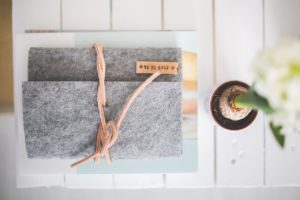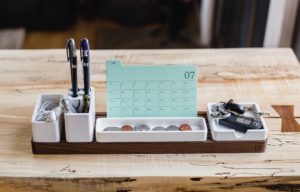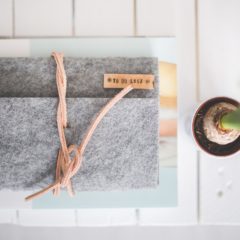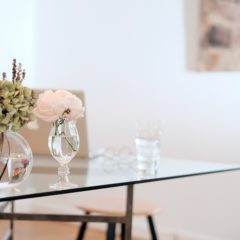Before you think about organising your home, you first need to clear the clutter. If you are dealing with too many excess items it will make it difficult to maintain an organised home.
Creating organisation across all aspects of your life makes the day to day much easier to manage. Being organised keeps home and life running smoothly, especially when life gets hectic or the unexpected happens.
ORGANISING BY ROOM
An organised home can create a sense of calm.
- BEDROOM – When you think about organising your bedroom, aim to create a relaxing space that promotes a good nights rest. Remove any items that don’t belong in the bedroom. Resist leaving clothes on the floor or draped over furniture. Hang them or place directly into the laundry basket. Invest in good quality wardrobes that suit your needs. Have a good mix of hanging and drawer or shelf space. Utilise under bed storage for seasonal clothing and shoes.
- KITCHEN – Create meal preparation areas within the kitchen. Place the toaster, kettle and breadboard together along with plates bowls and cups you use most often at breakfast time. Place herbs, spices and cooking utensils in a drawer or cupboard close to the stove top. Give appliances you use regularly the best spots in the kitchen. If you bake often, consider placing the mixer on the bench close to a power point. If you love to make a smoothie every morning, keep the blender on the bench ready to go.
- BATHROOM – Use containers inside drawers and cupboards to keep like items together. This also helps to prevent items from falling over and getting lost at the back of the cupboard. Place the items you use the most towards the front of the shelf or in the top drawer. Allocate a drawer or shelf to each family member to keep their personal belongings. Use a container to hold children’s bath toys.
- LINEN – Keep sheet sets together by folding them and placing them into the matching pillow case. Stack sheets, quilt covers and blankets in order of size. Label the shelf so household members can easily identify the size they need. Stack towel sets for each bathroom together. Towels, hand towels, washer and bathmat, that way you can quickly change out the linen with a fresh set.
- CLOTHING and SHOES – Seasonal clothing and shoes that you are not currently wearing should be removed from your day to day wardrobe space. Utilise under bed storage, high shelves or place them to the back of hanging sections. Use low eye level hanging racks and drawers for children’s rooms so that they can easily access their items. If you plan to keep clothing that children have outgrown to pass onto younger siblings, place them into a plastic storage container and label them. For example: Boys, Size 4, Winter.
HOME MANAGEMENT
Home management is about organising and putting in place systems and structure for a neat and efficient home.
- FAMILY COMMAND CENTRE – This is essentially a way for the family to communicate. Choose a central place in the house. The kitchen works well as this is often the hub of the home. At a minimum you should include a chalk board or white board for messages and reminders. A calendar to track each family members schedule. A place for the weeks dinner menu. A list of emergency phone numbers and important contacts. You can also include a place for items such as school notices, incoming mail and receipts, a key holder and device chargers. Don’t forget to add a place for stationary.
- DAILY SCHEDULE – Create one page for each day of the week. Put the day and date at the top of the page. Divide the daily schedule into different sections. For example: Important Reminders, People to Call, Places to Go, Food to Buy, Bills to Pay and Tasks to Complete. As you think of things that you need to do, write it down in the corresponding sections of that day’s schedule. Refer to the daily schedule throughout each day to make sure you don’t forget any tasks.
- MEAL PLANNING – Each week take a moment to plan out the meals for the week. Write down what you plan to make for breakfast, lunch, dinner, snacks and dessert. This will help you to create a shopping list for the week. Go through the weekly grocery store specials to get ideas. If chicken is on special this week, plan to include chicken dishes in your menu. Make a meal plan for children’s lunch boxes as well as lunches or snacks to take to work. Planning ahead for what meals you need to create throughout the week and having all ingredients on hand ready to go takes the stress out of meal preparation.
- EMERGENCY AND DISASTER PLANS – Every home should have a written disaster plan relevant for where you live. For example, if you live in a bush fire, flood or cyclone prone area you should have a plan to follow in case you are directly affected by such an event. Every family member should be aware of what to do when faced with an emergency situation. As well as having a written plan you should also keep supplies you may need such as torches, spare batteries and tinned food. Check your supplies and action plans regularly and make sure everything is in place and up to date. Its also important to have a house fire action plan and practice your escape route with all family members. Don’t forget to check the smoke alarms and change the batteries at least annually.
BUDGET, BILLS AND PAPER
Learning about organising your money effectively is as important as organising your home.
- CREATE A BUDGET – It’s not uncommon for families today to live pay check to pay check. This means that all the money is usually spent before it even comes in, there is never enough or any left over. The best way to tackle this and get on top of your finances is with a written budget. A written budget will help you to allocate where your money goes each week and be more conscious of how you are spending it. A budget will help you to understand your biggest expenses and where you can cut back to create savings.
- BILL PAYING – Creating an effective system for paying bills means money is set aside for upcoming expenses. Bills get paid on time avoiding those nasty late fees. I like to keep a folder to place all bill notices in when they arrive. Highlight the due date and the amount due. Keep a list showing all bills that are due for that month in the order that they are to be paid. Cross them off as you pay them. I also like to make a note on the calendar 2 days before the bill is actually due, that way I’m reminded and pay it early.
- RECEIPTS – On a busy day out we can come home with a handful of receipts that often get tossed on the kitchen bench or left crumpled at the bottom of a handbag. Avoid searching for lost receipts and keep them all in the one place. I’ve tried a few different ideas but I’ve found that a small box with a lid works best for me. It’s easy just to toss receipts in and just as easy to look through to find the one you want. You can use an old shoe box or buy something from a stationary store. I like to clean out the receipt box at the end of each month. I file any receipts I need to hang onto for warranties or possible returns.
- FILING SYSTEMS – With a myriad of incoming paper it pays to have an effective filing system. As each item comes into the house decide where it needs to go the first time you handle it. Firstly set up 3 folders or trays labelled, To Do, To Pay and To File. Anything else that you have read and requires no further action can go into the bin. Secondly have a filing cabinet or filing box to keep any papers you need to retain long term or access regularly. Such as copies of your house insurance, pay slips or medical records. Thirdly use an archive box to store any paperwork that you no longer need regular access to but need to retain for several years, such as tax returns. I like to go through the filing annually and remove any paperwork I no longer need to keep.
CHILDREN
Routine and predictability creates a sense of security for children.
- CHILDREN’S ARTWORK – It can be tempting to keep everything your child creates when they are young, so it’s important to put a limit on how much you hang on to. A plastic archive box with a folder labelled for each year is a good long term storage option. It also sets a limit as to how much each folder will hold. Display artwork in frames on the wall or pinned to a notice board. Then when new work comes in, keep only your favourite pieces to add to a scrapbook page or the archive folder.
- TOYS AND GAMES – Make it easy for children to find the toys they wish to play with by using clear plastic containers with labels on the front. Place like toys together in each box and label with a picture for children who cannot read yet. For example you could have one box for each type of toys you need to store. Dolls and clothes, dinosaurs and animals, trucks and cars, craft supplies, building blocks or games. Use lids that are easy for children to put on and take off and that allows you to stack the boxes to save space. Putting like items together in each box also makes it easy for children to pack their toys away.
- SCHOOL AND SPORT – Within your Family Command Centre provide a small box for children to place any correspondence they bring home from school, sport teams or extra curricular activities. Use this space to place notes or payments that children need to return. This will make it easy for children to know where to place any notes and for you to attend to them. A family calendar that allows you to list each persons name across the top and has the days of the month down the side works best for tracking each family members school, sport and extra curricular activities for the month. You can purchase these in stores or you can make one yourself.
- CHILDREN’S POSSESSIONS – Place hanging clothing at eye level and use low shelves and drawers therefore encouraging children to be responsible for their own items. Use furniture and storage that is easy for children to open and close. Use labels to assist children in finding items and packing them away. Try cycling children’s toys and games rather than having everything out at once. You can keep excess items in a large plastic storage container out of sight and change out the toys on a weekly or monthly basis.
GENERAL TIPS ABOUT ORGANISING YOUR HOME
An organised home isn’t just about organising your home to look a certain way, its about how your home functions.
- TIDY AS YOU GO – A good habit to get into is to tidy an area before you leave it and move onto the next thing. Place cushions or throw rugs back into place on the couch. Take any dishes to the kitchen. Place toys back into their container and take any other items back to the room they came from. If children have been playing with toys in the bedroom and now wish to go outside, set a 5 minute tidy time to clean up before they move onto the next activity. Doing a quick tidy of a room you have been using will help keep things in place and reduce the amount of mess at the end of the day.
- EVERYTHING HAS A PLACE – A basic rule to follow about organising your home is to allocate a place for each item. This is where that item belongs and where you will return it to when it is no longer being used. This makes it easier to find things when you need them. Additionally each family member will know where to put each item when they have finished using it.
- HOME STORAGE – When purchasing furniture and storage for the home, consider its practicability and function as well as how it looks. You need pieces that will work for your home and the items you need to store. Declutter your space and organise your items before purchasing new storage or furniture. This will ensure you get the right piece to suit your needs.
- DEDICATED AREAS – A helpful tip about organising in the home is to keep items in the area you use them. For example, keep bathroom cleaning supplies in the bathroom and computer and office supplies in the study. Also keep like items together. This could be a basket to hold all items for gift wrapping or placing the sewing basket and mending supplies next to the sewing machine. Keeping like items together in the area you use them will save you time. No more time wasted hunting down supplies from all over the house to complete the task.
The best way to go about organising your home is to chose a method that is easy to maintain and works for everyone.
It may seem hard to get started and know where to begin, but once you take the first step, it will set you on the road to an organised home.
Learn more about organising, home management, paper handling, meal planning and many more useful ideas and tips about organising your home.
Click on the images below to read more……
Elegant-Organised-Stylish-Functional
Organised Chic’











